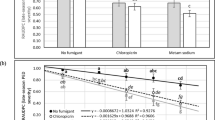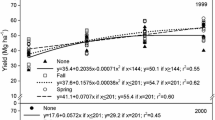Abstract
Metam sodium is a widely used soil fumigant for Verticillium wilt management in most potato production regions of the United States. Environmental concerns regarding volatilization losses have led to restrictions on the use of metam sodium. The potato industry adapted to these restrictions by replacing metam sodium applications through sprinkler irrigation with shank injection applications of the fumigant. Previous research established parameters for effective shank application of metam sodium based on soil temperature, injection depth and rate of fumigation. However, these recommendations were based on research conducted under coarse-textured soil conditions with a low organic matter (OM) content (<1.3%). However, many potato production soils in North Dakota and Minnesota have a finer silt loam texture and OM contents of >2.5%. Therefore, it is important to know whether metam sodium fumigation recommendations for coarse-textured soils can be adapted to fine-textured soils. Two field trials were conducted using a split strip-block design for studying metam sodium efficacy in managing wilt. In both years, metam sodium injection depth and soil temperature at the time of injection did not result in significant differences in any study variable evaluated. All metam sodium fumigation rates significantly (P < 0.05), lowered Verticillium microsclerotia, reduced wilt severity, and improved tuber yield compared to non-treated plots. However, significant differences among fumigation rates were not observed across any variable evaluated. A relatively low rate of 373 l/ha is as effective as higher metam sodium rates for effective control of Verticillium wilt. Results presented here suggest that current metam sodium recommendations for shank injection applications in coarse-textured soils can be implemented in field soils with a fine texture and higher OM content.
Resumen
Metam sodio es un fumigante del suelo ampliamente utilizado para el manejo del marchitamiento por Verticillium en la mayoría de las regiones productoras de papa de los Estados Unidos. Las preocupaciones ambientales en relación a las pérdidas por volatilización han conducido a restricciones en el uso de Metam sodio. La industria de la papa se ha adaptado a estas restricciones mediante el reemplazo de las aplicaciones de este fumigante por la vía de riego por aspersión con aplicación por inyección de mango del producto. Investigaciones previas establecieron parámetros para aplicación efectiva de mango de metam sodio basada en la temperatura del suelo, profundidad de la inyección y el nivel de la fumigación. No obstante, estas recomendaciones se basaron en investigación llevada a cabo bajo condiciones de un suelo de textura gruesa, con un bajo contenido de materia orgánica (OM) (<1.3). No obstante, muchos suelos de producción de papa en Dakota del Norte y Minnesota tienen textura limosa más fina y contenidos de OM de >2.5%. De aquí que es importante saber si las recomendaciones de la fumigación con metam sodio para suelos de textura gruesa se pueden adaptar a los de textura fina. Se condujeron dos ensayos de campo utilizando un diseño de bloques divididos para estudiar la eficacia del metam sodio en el manejo de la marchites. En ambos años, la profundidad de la inyección del fumigante y la temperatura del suelo al momento de la inyección no resultó en diferencias significativas en ninguna de las variables evaluadas del estudio. Todas las dosis de fumigación del metam sodio bajaron significativamente (P < 0.05) los microesclerocios de Verticillium, redujeron la severidad de la marchites y mejoraron el rendimiento de tubérculo en comparación con los lotes no tratados. No obstante, no se observaron diferencias significativas por los niveles de fumigación entre las variables evaluadas. Una dosis relativamente baja de 373 l/ha es tan efectiva como dosis más altas de metam sodio para un control efectivo de la marchites por Fusarium. Los resultados que aquí se presentan sugieren que las recomendaciones actuales de metam sodio para la aplicación por la inyección de mango en suelos de textura gruesa pueden implementarse en suelos del campo con textura fina y contenido de OM mas alto.


Similar content being viewed by others
References
Anderson, M.J. 2001. A new method for non-parametric multivariate analysis of variance. Austral Ecology 26: 32–46.
Ben-Yephet, Y., and Frank. Z.R. 1985. Effect of soil structure on penetration by metham-sodium and of temperature on concentrations required to kill soilborne pathogens. Phytopathology 75: 403–406.
Ben-Yephet, Y., E. Siti, and Z. Frank. 1983. Control by metam-sodium in loessial soil and effect on potato tuber yields. Plant Disease 67: 1223–1225.
Busch, L.V. 1973. Effect of some cropping practices on survival of Verticillium. American Potato Journal 50: 381–382.
Davis, J.R., and D.O. Everson. 1986. Relation of Verticillium dahliae in soil and potato tissue, irrigation method, and N-fertility to Verticillium wilt of potato. Phytopathology 76: 730–736.
Davis, J.R., and Hulsman. O.C. 2001. Verticillium wilt. In: Compendium of Potato Diseases. APS Press, Minneapolis, pp: 45–46.
Davis, J.R., O.C. Huisman, D.O. Everson, and A.T. Schneider. 2001. Verticillium wilt of potato: a model of key factors related to disease severity and tuber yield in southeastern Idaho. American Journal of Potato Research 78: 291–300.
Dungan, R.S., J. Gan, and S.R. Yates. 2003. Accelerated degradation of methyl isothiocyanate in soil. Water, Air, and Soil Pollution 142: 299–310.
Easton, G.D., M.E. Nagle, and D.L. Bailey. 1972. Effect of annual soil fumigation and pre-harvest vine burning on Verticillium wilt of potato. Phytopathology 62: 520–524.
Fry, W.E. 1978. Quantification of general resistance of potato cultivars and fungicide effects for integrated control of potato late blight. Phytopathology 68: 1650–1655.
Gan, J., S.K. Papiernik, S.R. Yates, and W.A. Jury. 1999. Temperature and moisture effects of fumigant degradation in soil. Journal of Environmental Quality 28: 1436–1441.
Gerstl, Z., U. Mingelgrin, and B. Yaron. 1977. Behavior of Vapam and methyl isothiocyanate in soils. Soil Science Society of America Journal 41: 545–548.
Goring, C.A.I. 1962. Theory and principles of soil fumigation. Advance Pest Control Research 5: 47–84.
Hamm, P.B., R.E. Ingham, J.R. Jaeger, W.H. Swanson, and K.C. Volker. 2003. Soil fumigant effects on three genera of potential soilborne pathogenic fungi and their effect on potato yield in the Columbia Basin of Oregon. Plant Disease 87: 1449–1456.
Johnson, D.A., and T.F. Cummings. 2015. Effect of extended crop rotations on incidence of black dot, silver scurf, and Verticillium wilt of potato. Plant Disease 99: 257–262.
Johnson, D.A., and J.K.S. Dung. 2010. Verticillium wilt of potato – the pathogen, disease and management. Canadian Journal of Plant Pathology 32: 58–67.
Kaufman, D.D., J. Katan, D.F. Edwards, and E.D. Jordan. 1985. Microbial adaptation and metabolism of pesticides. In: Agricultural Chemicals of the Future. J.L. Hilton. [Ed.] Rowman & Allanheld Press, NJ pp: 437–451.
Kolbezen, M.J., D.E. Munnecke, W.D. Wilbur, L.H. Stolzy, F.J. Abu-El-Haj, and T.E. Szuszkiewicz. 1974. Factors that affect deep penetration of field soils by MeBr. Hilgardia 42: 465–492.
Lembright, H.W. 1990. Soil fumigation: Principles and application technology. Supplemental. Journal of Nematology 22: 632–644.
MacRae, A., and J. Noling. 2010. Overview of new EPA regulations affecting use of metam sodium and metam potassium. University of Florida Extension HS1167.
Nicot, P.C., and D.I. Rouse. 1987a. Precision and bias of three quantitative soil assays for Verticillium dahliae. Phytopathology 77: 875–881.
Nicot, P.C., and D.I. Rouse. 1987b. Relationship between soil inoculum density of Verticillium dahliae and systemic colonization of potato stems in commercial fields over time. Phytopathology 77: 1346–1355.
O’Hara, R.B., and D.J. Kotze. 2010. Do not log transform count data. Methods in Ecology and Evolution 1: 118–122.
Ochiai, N., M.L. Powelson, R.P. Dick, and F.J. Crowe. 2007. Effects of green manure type and amendment rate on Verticillium wilt severity and yield of Russet Burbank potato. Plant Disease 91: 400–406.
Oksanen, J., F.G. Blanchet, R. Kindt, P. Legendre, P.R. Minchin, G.L. Simpson, P. Solymos, M.H.H. Stevens, and H. Wagner. 2013. Vegan: Community ecology package. R package verison 2.0-7. http://vegan.r-forge.r-project.org/.
Pasche, J.S., I. Mallik, N.R. Anderson, and N.C. Gudmestad. 2013a. Development and validation of a real-time PCR assay for the quantification of Verticillium dahliae in potato. Plant Disease 97: 608–618.
Pasche, J.S., A.L. Thompson, and N.C. Gudmestad. 2013b. Quantification of field resistance to Verticillium dahliae in eight russet-skinned potato cultivars using real-time PCR. American Journal of Potato Research 90: 158–170.
Pasche, J.S., R.J. Taylor, N.L. David, and N.C. Gudmestad. 2014. Effect of soil temperature, injection depth, and metam sodium rate on the management of Verticillium wilt of potato. American Journal of Potato Research 91: 277–290.
Powelson, M.L., and R.C. Rowe. 1993. Biology and management of early dying of potatoes. Annual Review of Phytopathology 31: 111–126.
Rowe, R.C., and M.L. Powelson. 2002. Potato early dying: Management challenges in a changing production environment. Plant Disease 86: 1184–1193.
Rowe, R.C., and M.L. Powelson. 2008. Potato health management: a holistic approach. In: Potato health management (2nd ed.) D.A. Johnson [Ed.] St. Paul: American Phytopathological Society Press pp: 1–5.
Saeed, I.A.M., D.I. Rouse, J.M. Harkin, and K.P. Smith. 1997. Effects of soil water content and soil temperature on efficacy of metam sodium against Verticillium dahliae. Plant Disease 81: 773–776.
Saeed, I.A.M., D.I. Rouse, and J.M. Harkin. 2000. Methyl isothiocyanate volatilization from fields treated with metam-sodium. Pest Management Science 56: 813–817.
Shaner, G., and R.E. Finney. 1977. The effect of nitrogen fertilization on the expression of slow-mildewing resistance in Knox wheat. Phytopathology 67: 1051–1056.
Simpson, C.R., S.D. Nelson, J.E. Stratmann, and H.A. Ajwa. 2010. Surface water seal application to minimize volatilization loss of methyl isothiocyanate from soil columns. Pest Management Science 66: 686–692.
Simpson, C.R., S.D. Nelson, and H.A. Ajwa. 2011. Impact of soil texture and organic matter on methyl isothiocyanate volatilization from soil columns. Journal of Agricultural Science and Technology 1: 194–198.
Tartier, Leon-M., and A. Devaux. 1977. Survey on Verticillium wilt of potatoes in the regions north of Montreal. Phytoprotection 58: 115–120.
Taylor, R.J., J.S. Pasche, and N.C. Gudmestad. 2005. Influence of tillage and method of metam sodium application on distribution and survival of Verticillium dahliae in the soil and the development of Verticillium wilt of potato. American Journal of Potato Research 82: 451–461.
Thomason, I.J., and M.V. McKenry. 1974. Part I, movement and fate as affected by various conditions in several soils. Hilgardia 42: 393–420.
Triky-Dotan, S., M. Austerweil, B. Steiner, Y. Peretz-Alon, J. Katan, and A. Gamliel. 2009. Accelerated degradation of metam-sodium in soil and consequences for root-disease management. Phytopathology 99: 362–368.
Tsror, L., E. Shlevin, and I. Peretz-Alon. 2005. Efficacy of metam sodium for controlling Verticillium dahliae prior to potato production in sandy soils. American Journal of Potato Research 82: 419–423.
Wheeler, D.L., and D.A. Johnson. 2016. Verticillium dahliae infects, alters plant biomass, and produces inoculum on rotation crops. Phytopathology 106: 602–613.
Wilhelm, S. 1955. Longevity of Verticillium wilt fungus in the laboratory and field. Phytopathology 45: 180–181.
Yates, S.R., J. Gan, S.K. Papiernik, R. Dungan, and D. Wang. 2002. Reducing fumigant emissions after soil application. Phytopathology 92: 1344–1348.
Yellareddygari, S.K.R., and N.C. Gudmestad. 2017. Bland-Altman comparison of two methods for assessing severity of Verticillium wilt of potato. Crop Protection 101: 68–75.
Zheng, W., S.R. Yates, S.K. Papiernik, and J. Nunez. 2006. Conversion of metam sodium and emission of fumigant from soil columns. Atmospheric Environment 40: 7046–7056.
Acknowledgements
The authors gratefully acknowledge the financial support of this research by RD Offutt, Co., Minnesota Area II Potato Growers Association, and AmVac, Inc. The authors also gratefully acknowledge the technical assistance of Dean Peterson and Russell Benz.
Author information
Authors and Affiliations
Corresponding author
Rights and permissions
About this article
Cite this article
Yellareddygari, S.K.R., Gudmestad, N.C. Effect of Soil Temperature, Injection Depth, and Rate of Metam Sodium Efficacy in Fine-Textured Soils with High Organic Matter on the Management of Verticillium Wilt of Potato. Am. J. Potato Res. 95, 413–422 (2018). https://doi.org/10.1007/s12230-018-9641-5
Published:
Issue Date:
DOI: https://doi.org/10.1007/s12230-018-9641-5




